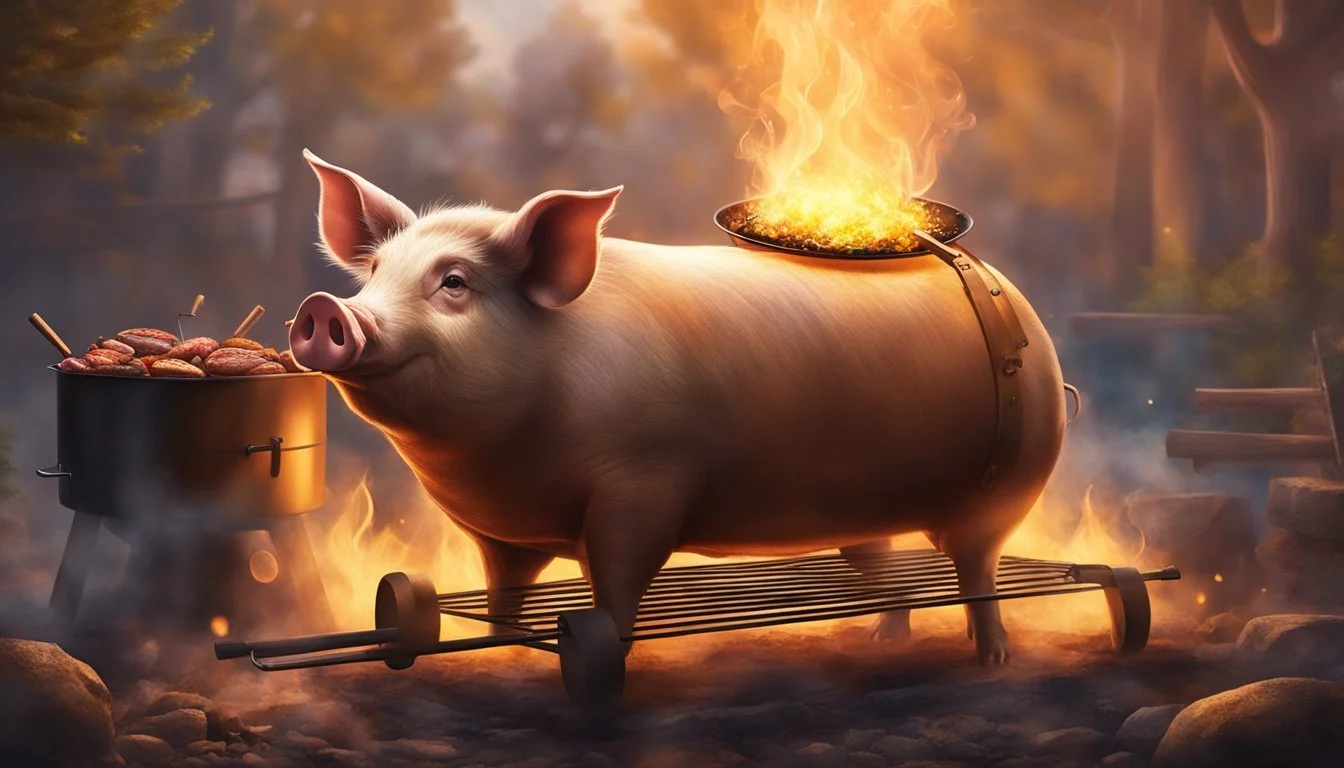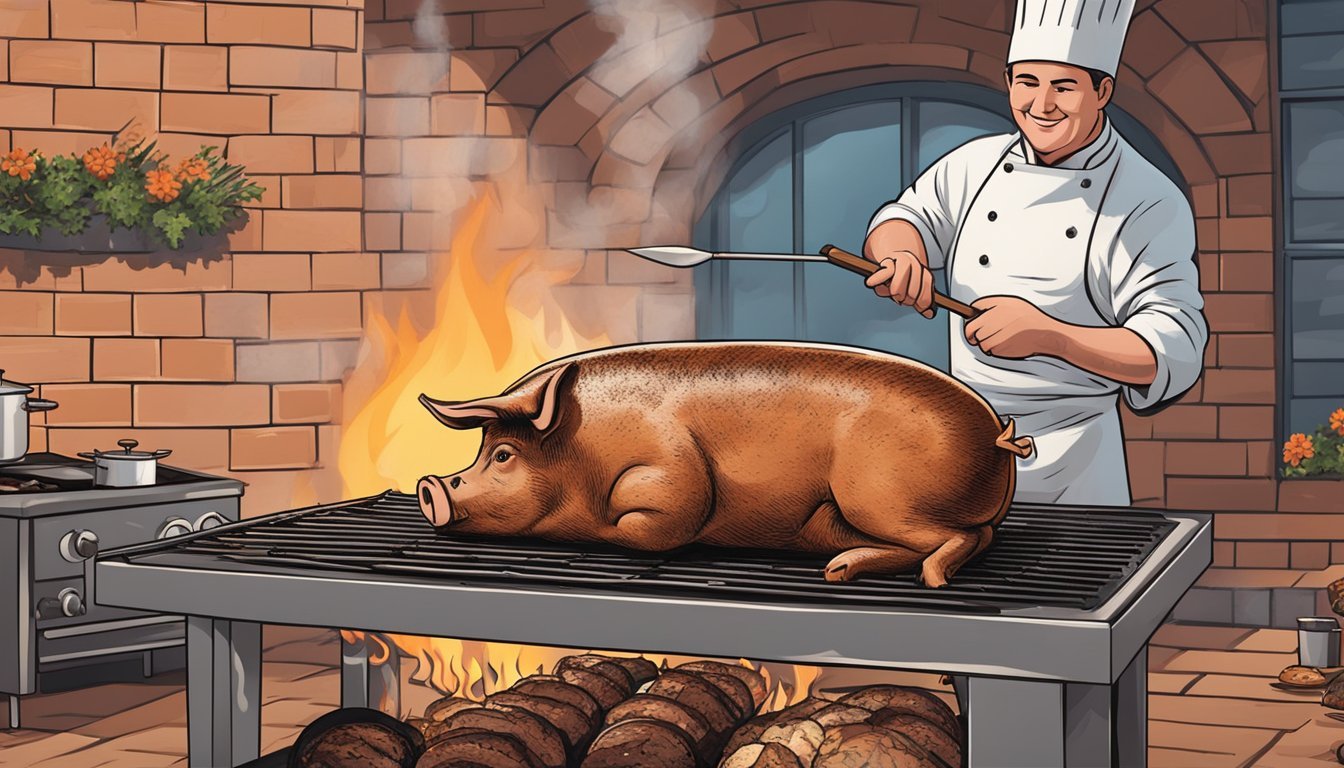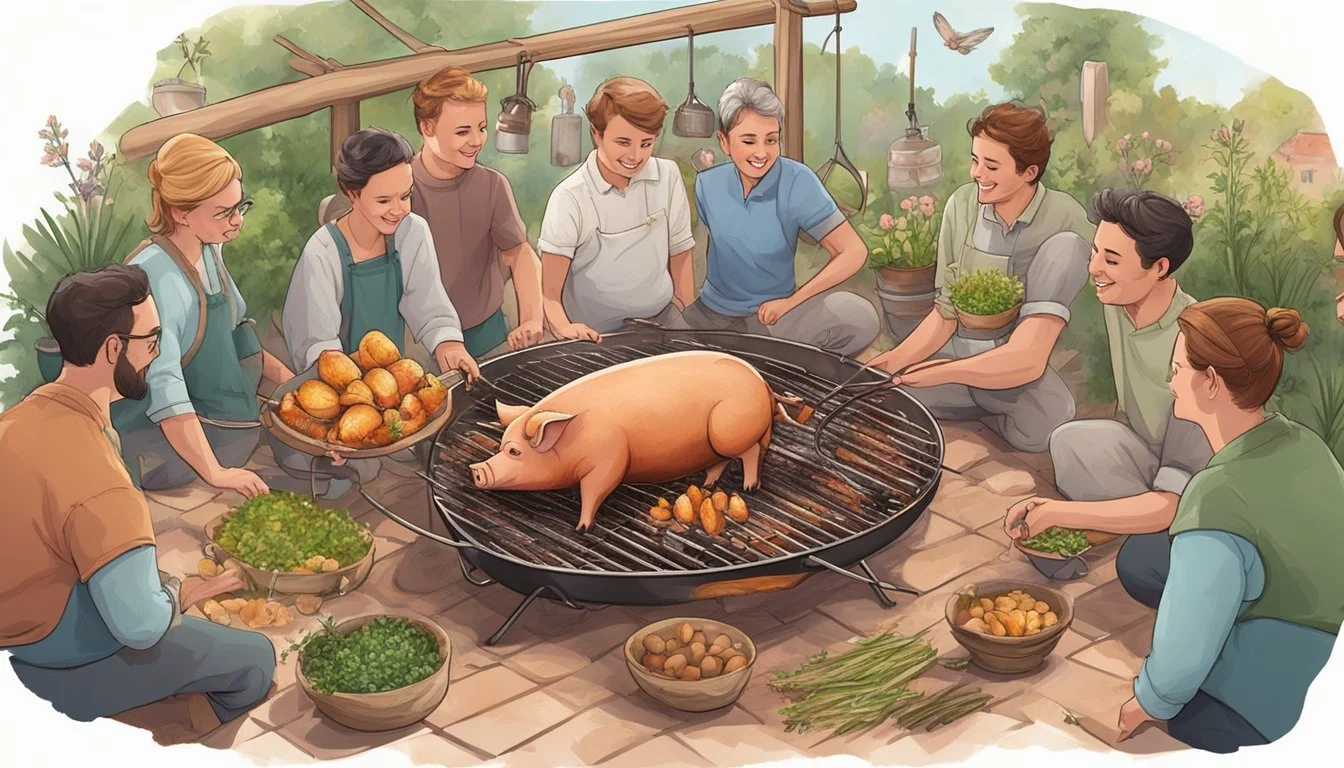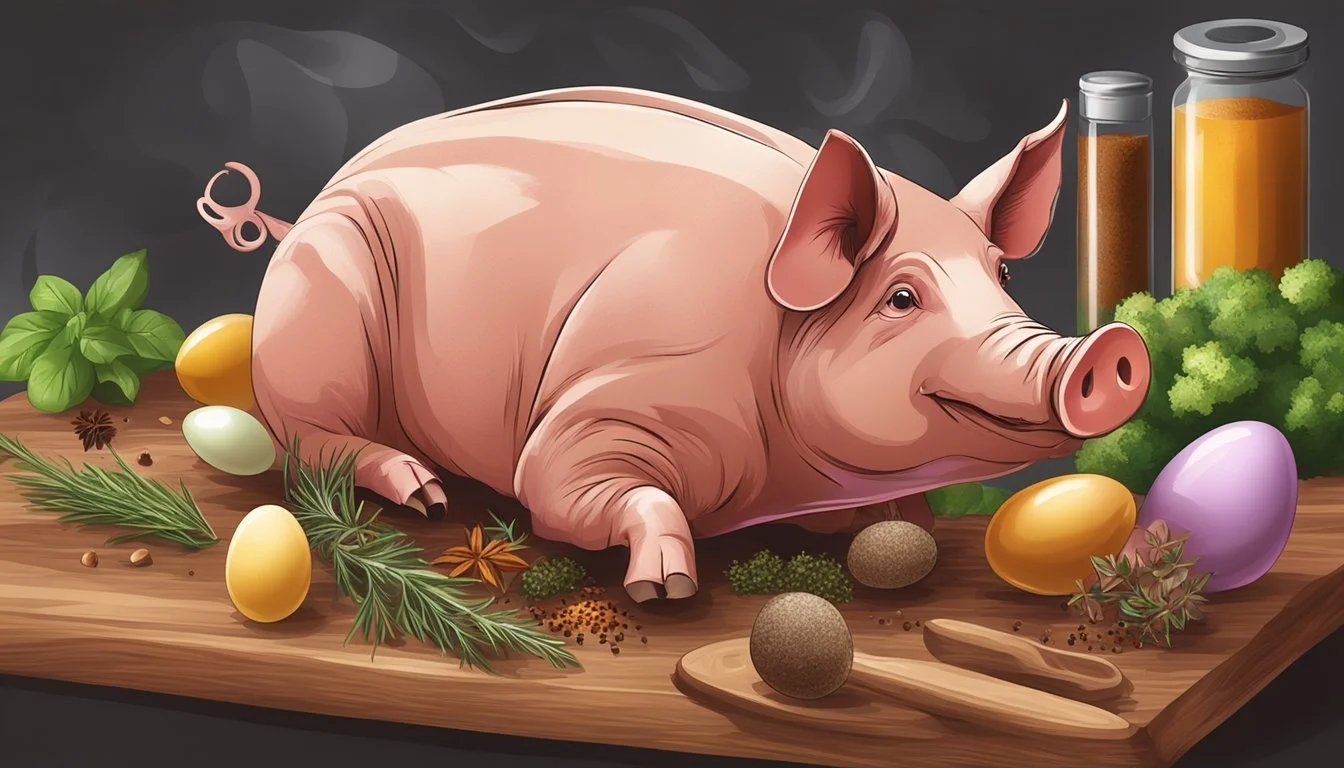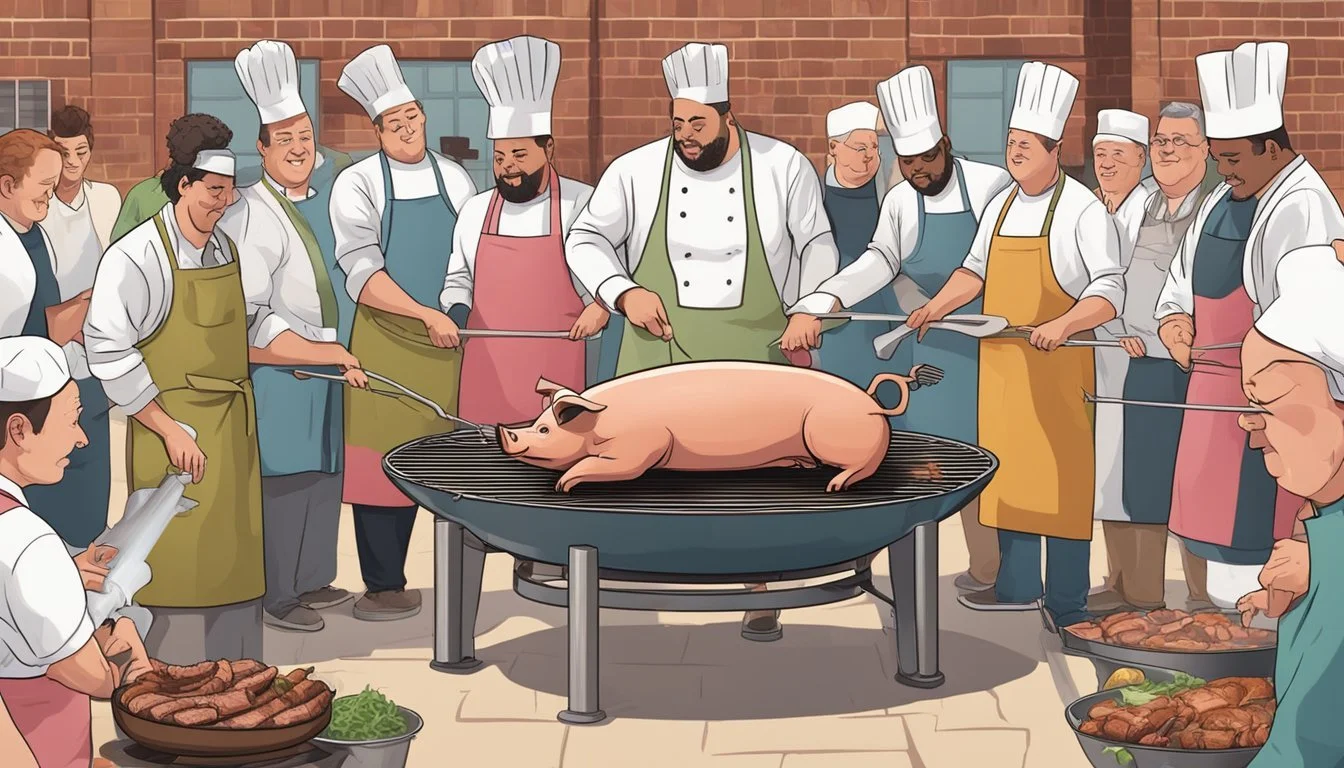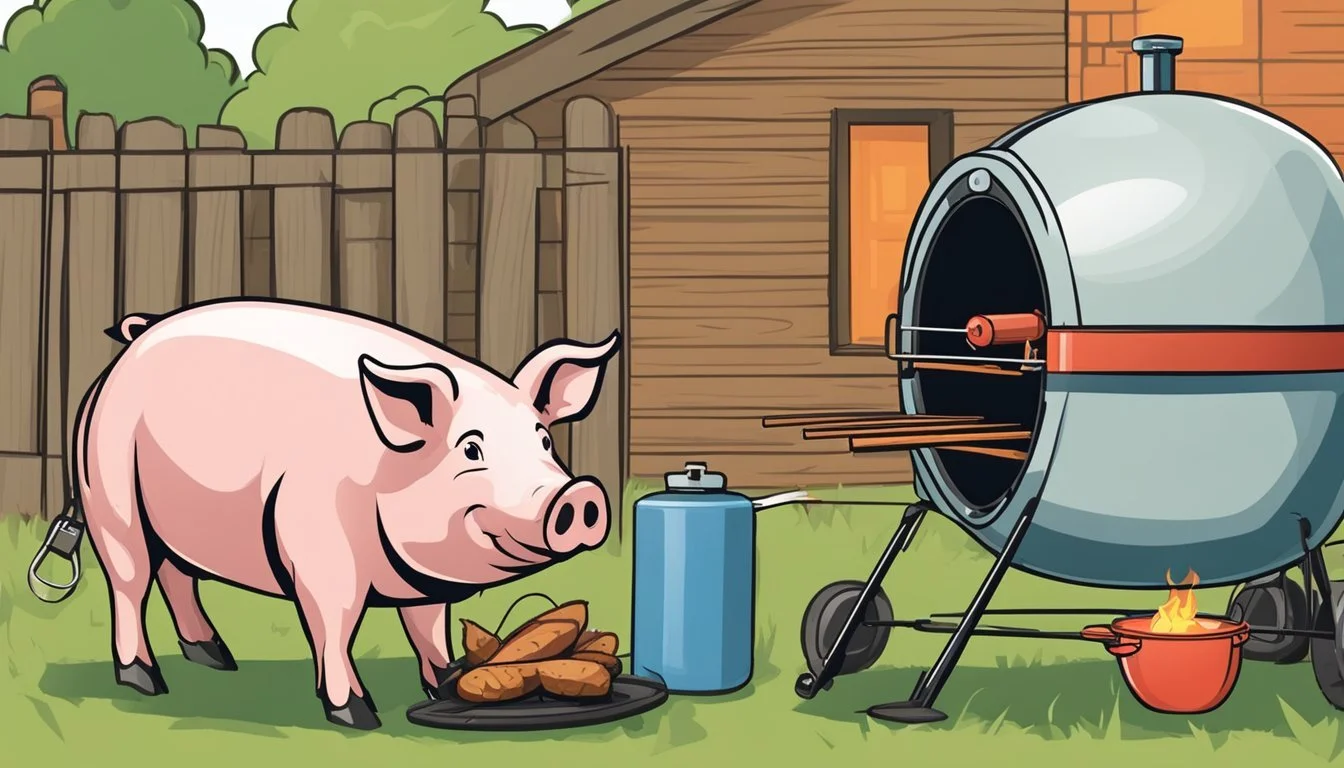BBQ Tips for Cooking a Whole Easter Pig
Mastering the Feast
Roasting a whole pig is a culinary tradition that turns a special occasion like Easter into a memorable feast. Cooking a whole hog requires attention to detail, from the method of roasting to the intricacies of flavor. Whether it's prepared on a pellet grill or in a specialized roaster, the process involves scoring the skin, ensuring even seasoning, and maintaining the right temperature. Achieving the perfect balance of crispy skin and tender, juicy meat demands both patience and precision.
A successful whole pig roast starts with proper preparation. The skin must be scored to help the fat render and to make the skin crisp up during cooking. Seasonings, typically a blend of salt, pepper, and other spices, are rubbed thoroughly into the skin. Some cooks prefer to coat the pig with a layer of yellow mustard before applying the dry rub, creating a sticky surface that helps the seasoning adhere and imparts a subtle tang to the meat.
Throughout the cooking process, maintaining an even temperature is crucial for the meat to reach the desired level of doneness without drying out. One should monitor the internal temperature, aiming for the shoulder meat to reach 195 degrees Fahrenheit, as this generally indicates the whole hog is ready. Once the pig is properly cooked through, it's time for the final steps of resting and carving before serving the succulent centerpiece of the Easter celebration.
Selecting the Perfect Hog
When choosing a hog for your Easter BBQ, considering the size and breed is crucial. It affects not only the quantity of meat but also the flavor.
Understanding Hog Sizes and Weights
An appropriate hog size ensures that all guests are satisfied while managing the practicalities of cooking times and required space. Here's a basic guideline to help you decide:
Small Hog: 50-150 lbs - Suitable for gatherings with fewer people.
Medium Hog: 150-250 lbs - Ideal for family reunions or neighborhood events.
Large Hog: 250+ lbs - Best for large community events.
Selecting a hog within the medium range, specifically around 150-250 pounds, provides a balance of manageability and yield of meat.
Choosing the Right Breed and Source
The breed can significantly influence the texture and flavor of the meat. Some popular breeds for barbecuing include:
Berkshire: Known for its rich and full flavor.
Duroc: Offers a good balance of fat and lean meat.
When sourcing your hog, consider local farmers for the freshest choice:
Local Farmers: Provides the advantage of knowing the hog's history and supporting the local economy.
One should ensure the hog's been raised with good welfare standards, which can noticeably affect the quality of the meat.
Essential Preparation
Properly preparing for a whole pig roast is a critical step to ensure a successful barbecue event. This involves gathering the right equipment and taking care to trim and score the pig appropriately, which will facilitate even cooking and optimal flavor.
Gathering Necessary Equipment
One needs a variety of tools and equipment to roast a whole pig. Firstly, a large enough roasting spit or grill is essential, capable of fitting the entire pig. For spit roasting, a sturdy spit that can bear the weight of the pig and a motor to rotate it are requirements. If using a grill, ensure it has a lid large enough to close over the hog.
Essential Equipment List:
Spit or large grill with a lid
Charcoal or wood chips (if using a charcoal grill or smoker)
Meat thermometer
Large table for preparation
Butcher's knife and sharpening steel
Scoring tool or a sharp knife
Stainless steel or wooden table for serving
Preparing the Hog: Trimming and Scoring
Before cooking, the pig needs to be prepared. This entails trimming excess fat and skin that not only affects the cooking time but also the crispness of the skin. A butcher's knife can be used for trimming the fat. Score the skin to allow the heat to penetrate deeply. Scoring involves making shallow cuts in a crosshatch pattern across the skin's surface. One must be careful not to cut too deep to avoid exposing the meat, which could dry out during cooking.
Lay the pig flat on a large table.
Trim off excess fat with a butcher's knife, leaving about 1/4-inch layer to keep the meat moist during roasting.
Score the skin with a sharp knife or scoring tool, creating a crosshatch grid pattern over the entire surface.
These steps are essential for rendering the fat and getting crisp skin, as well as ensuring the seasoning adheres properly and the pig cooks evenly.
Seasoning and Flavoring
For an unforgettable Easter feast, the key to a succulent whole pig lies in a balance of seasoning and flavoring, ensuring every bite is as savory as the next. The use of a well-crafted rub and the strategic application of marinades or injection liquids can elevate the pork's inherent flavors to new heights.
Creating a Flavorful Rub
A rub primarily combines salt, sugar, and a blend of spices and herbs, tailored to complement the rich taste of pork. Starting with the base, here's a straightforward rub recipe:
Kosher Salt: 1/2 cup
Brown Sugar: 1/2 cup
Paprika: 1/4 cup
Black Pepper: 2 tablespoons
Garlic Powder: 2 tablespoons
Onion Powder: 2 tablespoons
Dried Thyme: 1 tablespoon
Dried Oregano: 1 tablespoon
One should mix these dry ingredients until they are well combined. Before applying the rub, it's often recommended to coat the pig, both inside and out, with a thin layer of yellow mustard which acts as a 'glue', helping the seasoning adhere to the meat. This rub should be massaged thoroughly into every part of the pig, especially in crevices and exposed meat.
Using Marinades and Injecting Liquids
While a rub seasons the surface of the meat, marinades and injections introduce flavors directly into the muscle. A marinade typically combines acidic components like vinegar or citrus juice with herbs, spices, and oils. Here's an example of a balanced marinade:
Apple Cider Vinegar: 2 cups
Olive Oil: 1 cup
Worcestershire Sauce: 1/2 cup
Chopped Garlic: 1/4 cup
Rosemary: 2 tablespoons
The pig can be soaked in this marinade, or it can be applied periodically as a mop during cooking. For deeper flavor penetration, injecting liquids is an effective method. A simple injection mixture might include:
Apple Juice: 3 cups
Apple Cider Vinegar: 1 cup
Salt: 1/4 cup (dissolved)
Using a meat injector, the cook would inject this solution at various points throughout the pig's shoulders, hams, and loins. Injections should be evenly spaced to ensure that the internal meat of the pig remains moist and flavorful during the cooking process.
Setting Up the Cooking Area
To ensure succulent results and a smooth cooking experience, one must focus on setting up a proper cooking area. Achieving the optimal temperature and employing the correct fuel type are pivotal factors.
Preparing the Pit or Smoker
The foundation for roasting a whole pig is preparing the pit or smoker correctly. One should ensure that the pit is spacious enough to accommodate the pig and that it allows for a consistent temperature throughout the cooking process. For smokers, it is essential to establish a heat source that can maintain a steady temperature between 225-250°F (107-121°C) for long-duration cooking.
Ensure the smoker is clean: Before beginning, the interior should be free of residue to allow for proper airflow and to prevent unwanted flavors.
Check for proper ventilation: Proper airflow is critical in maintaining temperature and smoke quality.
Selecting the Right Type of Fuel
The fuel one chooses directly impacts the flavor of the pig and the overall cooking experience. Hardwoods such as oak, hickory, pecan, and fruitwoods like apple are preferred for their heat endurance and the subtle flavors they impart.
Charcoal: Provides a reliable heat source, suitable for maintaining a steady temperature.
Use lump charcoal for a more organic, wood-fired taste.
Briquettes are ideal for their long burn time and consistent heat output.
Wood:
Chunks: Ideal for long smokes, wood chunks smolder and burn slowly, providing a deep smoky flavor.
Chips: Best for short cooks or adding quick bursts of smoke, wood chips ignite and burn quickly.
Combining Fuel Sources: It's not uncommon to see charcoal used as the primary heat source, with wood chunks or chips added to introduce specific flavor profiles.
Cooking the Hog
When it comes to cooking a whole hog, precision in managing temperature and time, understanding the smoking process, and monitoring for perfect doneness are paramount for a successful BBQ feast.
Managing Temperature and Time
The mantra of 'low and slow' is at the heart of cooking a whole hog. To achieve a tender and flavorful result, one must cook the hog at a constant temperature of around 250°F. It's crucial to maintain a consistent heat source and keep the pig approximately 12 inches away from it. A whole hog can take anywhere from 6 to 24 hours to cook, depending on its size and the cooking temperature. One should periodically check the temperature to ensure it stays within the optimal cooking range.
Recommended Cooking Schedule:
Time Action Every hour Check and adjust temperature to maintain consistency. 8 hours into cooking Perform a thorough temperature check with a probe thermometer. As needed Adjust heat source to keep the temperature steady.
Understanding the Smoking Process
Smoking a whole hog imparts flavor and tenderness that's hard to replicate with other cooking methods. The smoke should be maintained as a gentle flow around the meat, ensuring it doesn't overpower the natural flavors. Hardwoods like hickory or oak are ideal for smoking as they give a moderate flavor that complements the pork without being too assertive. Importantly, one should avoid having the smoke appear thick and white, as this can impart a bitter taste; instead, aim for a thin, blue smoke indicating a well-managed fire.
Monitoring for Perfect Doneness
To ensure the whole hog is cooked to perfection, one must regularly monitor the internal temperature using a meat thermometer. The target internal temperature for the thickest parts, such as the shoulder, is around 195°F to 205°F. This range denotes that the connective tissues have broken down sufficiently to make the meat tender and ready to pull apart easily. It's best to probe various parts of the hog to confirm even cooking, taking care not to hit bone, which can skew the reading.
Key Temperatures to Monitor:
Location Ideal Internal Temperature Shoulder 195°F to 205°F Ham 160°F to 170°F Loin 145°F to 150°F
By attending to these details, one can master the art of smoking a whole hog, ensuring it is celebrated by all at the Easter gathering.
Additional Cooking Techniques
When cooking a whole pig, the methods used can greatly influence the flavor and texture of the meat. Understanding the nuances of roasting and grilling, as well as the benefits of various basting and mopping strategies, ensures a delectable result.
Exploring Roasting and Grilling Options
Roasting: Roasting a whole pig usually involves using indirect heat in a large grill or roasting box. It allows the pig to cook evenly and develop a rich flavor profile. For optimal results, one should maintain a consistent cooking temperature, generally around 275 degrees Fahrenheit. This low and slow approach helps to tenderize the meat.
Equipment Considerations:
Pro 34 or larger size grill suitable for whole pigs
Roasting box for a more controlled environment
Grilling: Grilling a whole pig entails a more hands-on approach, often utilizing a rotisserie setup or a large enough grill to accommodate the size of the pig. The goal is to achieve a crisp exterior while ensuring the inside remains juicy.
Key Grilling Points:
High, direct heat for crispy skin
Rotisserie method for even cooking
Mastering the Art of Basting and Mopping
Basting: Basting involves periodically coating the pig with a sauce or marinade. This technique enhances flavor and helps retain moisture. One should baste the pig every hour to avoid drying out the meat.
Basting Tips:
Use a brush or mop to apply sauce
Avoid over-basting to prevent soggy skin
Mop Sauce: A mop sauce, typically composed of vinegar, spices, and other flavorings, is applied during cooking to keep the meat moist and infuse extra flavor. It's thinner than a traditional barbecue sauce and perfect for repeated application without overwhelming the meat's taste.
Mop Sauce Application:
Apply mop sauce with a dedicated mop or basting tool
Frequent application, roughly every 30 to 45 minutes
In summary, both roasting and grilling offer unique benefits for cooking a whole pig. Basting and applying mop sauce are key to maintaining moisture and enhancing flavor throughout the cooking process. By incorporating these techniques, one can achieve a perfectly cooked Easter pig that's sure to impress.
Finishing Touches
As the roasted pig nears completion, the final steps are critical to ensuring the ideal texture and flavor. These finishing touches will elevate the succulence of the meat and the aesthetic appeal of your presentation.
Achieving Crisp Skin and Crackling
To ensure the skin of the pig attains the coveted crispness and develops into delightful crackling, one can adopt the following measures:
Increase Heat: For the last hour of cooking, raise the heat to crispen the skin. Monitor it closely to prevent burning.
Oiling and Salting: Lightly oil the skin and generously salt it to aid the formation of a golden-brown crust.
Maintaining even heat is essential, particularly on the belly and shoulders, where the skin needs to be rendered to perfection without overdrying the tenderloin and ribs nested beneath.
Resting and Carving the Hog
Post-roasting, the pig must be allowed to rest, crucial for:
Juiciness: Letting the pig rest for about 20-30 minutes allows juices to redistribute throughout the shoulders, loin, and belly.
Ease of Carving: Resting stabilizes the meat, facilitating cleaner cuts.
When carving:
Separate Sections: Begin with removing the crackling. Then, proceed to dissect the hog into manageable sections—shoulders, hams, loin, and ribs.
Portioning: Offer a variety of cuts for your guests:
Chopped Pork: Ideally from the shoulder, offering a balance of fat and meat.
Sliced: Loin and tenderloin yield elegant, lean slices.
Pulled Pork: Shred meat from the belly and hams for succulent pulled pork.
Utilize a sharp knife or a butcher's saw to butterfly the backbone if you need to lay the pig flat for an impressive spread. Remember, presentation is as important as flavor; aim for a roasted pig display that's as inviting to the eye as to the palate.
Serving the Easter Pig
After a whole pig has been expertly cooked, serving it in a manner that honors the preparation is crucial. The presentation should be inviting, and accompaniments should enhance the flavors and add to the festive experience.
Complementing with Sides and Sauces
Sauces:
BBQ Sauce: A traditional, homemade BBQ sauce can be served on the side, allowing guests to add the amount they prefer. A tangy sauce with a hint of sweetness pairs well with the rich meat.
Glaze: During the last hours of cooking, one can apply a glaze, such as a mixture of honey and brown sugar, to the pig for a caramelized finish.
Sides:
Coleslaw: A crisp, refreshing coleslaw balances out the richness of the meat.
Beans: Baked beans, seasoned with a bit of the same BBQ sauce used for the pig, can create a harmonious flavor profile.
Presentation and Serving Tips
Carving:
Prioritize Visibility: The host should carve the pig where guests can see, often making the first cuts into the shoulders and hams.
Methodical Approach: One should remove large sections of meat and then slice them into serving portions, ensuring each plate receives a good mix of textures and flavors.
Serving:
Platters: Serve the meat on large platters, garnished with fresh herbs for an eye-catching appearance.
Sandwiches:
Buns and Rolls: Offer a selection of buns and rolls for guests who prefer to make sandwiches. This can be an informal and interactive way for guests to enjoy the BBQ.
BBQ Staples: It's customary to include classic BBQ staples such as:
Disposable Cutlery: Ensure there is an ample supply of plates, napkins, and cutlery for convenient eating.
By focusing on complementary flavors and engaging presentation, one can ensure the Easter pig becomes a memorable centerpiece of the celebration.
Advanced Topics
In the pursuit of perfecting the craft of barbecue, enthusiasts often seek advanced strategies and experiences. These include hosting educational events and participating in or learning from traditional competitions.
Hosting a Barbecue Class or Event
Hosting a barbecue class or event is an excellent opportunity for pros to share their expertise and for attendees to learn advanced techniques. When organizing a class, it's essential to focus on the specifics of BBQ processes like choosing the right wood, managing fire control, and meat preparation. A successful event can also cover advanced topics such as:
Butchering: Guided instructions on how to prep a pig for roasting from start to finish.
Temperature Control: In-depth discussions and practical tips on how to maintain consistent temperatures during the long smoking process.
Utilizing live demonstrations and hands-on training can significantly enhance the learning experience. Classes often culminate in a communal feast, where participants get to enjoy the fruits of their labor, promoting a sense of community and shared accomplishment.
Learning from BBQ Traditions and Competitions
Events like Memphis in May, one of the most prestigious barbecue competitions, offer a treasure trove of knowledge. Observing teams as they prepare their entries provides invaluable insights into time-tested methods and innovative tactics. Topics of interest include:
Marination and Rubs: Detailed explorations of flavor profiles and ingredient ratios.
Smoking Techniques: Observing the subtle nuances of smoking that differentiate a good BBQ from a great one.
Barbecue enthusiasts can learn from these traditions by:
Attending competitions as a spectator
Participating in contests to gain hands-on experience
Interacting with seasoned competitors
While the competitive atmosphere is intense, the camaraderie among BBQ contestants is often generous, with many willing to share tips and advice. A proactive approach to learning and engaging with these communities offers a fast track to elevating one's barbecue skills.
Aftercare and Safety
After cooking a whole pig, proper aftercare is crucial to ensure food safety and maintain equipment longevity. One must handle leftovers with care to prevent foodborne illnesses and clean up equipment to preserve its function for future use.
Handling Leftovers and Storage
Leftovers should be addressed promptly to inhibit bacterial growth. One must store the pork correctly by following these steps:
Cool it down: Ensure that the cooked pig is not left out for more than two hours. Use patience and vigilance, as this time is critical.
Portion it: Divide the pork into smaller portions to expedite cooling.
Wrap it: Utilize aluminum foil or airtight containers to seal the pork effectively.
Refrigerate or freeze: Keep the pork under 40 degrees Fahrenheit if refrigerated, or freeze it if you plan to store it for an extended period.
Maintaining Equipment and Cleaning Up
Proper post-cooking equipment care is essential for safety and to ensure its future performance.
Dismantle: Wait for the equipment to cool down before you start cleaning it.
Scrub and sanitize: Clean each component with the appropriate cleaning agents. Do not overlook any residual grease or food particles.
Dry and store: Ensure that all equipment is thoroughly dry before storing to prevent rust or mildew.
Safety inspection: Regularly check for any wear and tear or potential hazards that could affect future use.
Frequently Asked Questions
What is the recommended size for a whole pig when barbecuing?
Typically, for a BBQ, one should aim for a whole pig that weighs between 50-150 pounds. The size impacts both the flavor and cooking time.
How long does it take to cook a whole pig on a BBQ?
The cooking time varies depending on the size of the pig and the heat of the grill or smoker but generally ranges from 4 to 12 hours. A meat thermometer should read an internal temperature of 190-200 degrees Fahrenheit to ensure the meat is properly cooked.
What are some methods to enhance the flavor of the meat?
Marinades: 24-48 hours of marinating can infuse the meat with deeper flavors.
Rubs: Applying a mixture of spices and herbs onto the pig’s skin before cooking adds another layer of flavor.
Wood Choice: Using different woods for smoking can impart distinct smoky tastes.
Sauces: Applying bbq sauce during the final stages of cooking can add a tangy or sweet glaze to the meat.
Injection: Flavor injections directly into the meat can also enhance the overall taste profile.
Do you need a spit or smoker for cooking a whole hog?
One can cook a whole hog on a traditional BBQ grill, smoker, or using a rotisserie spit. If the pig is too big for the grill, a smoker or a spit specifically designed for whole pigs may be required.
What type of wood is best for smoking a whole pig?
Fruit woods like apple or cherry provide a sweeter smoke, while hickory or oak impart a more robust flavor. The choice of wood contributes significantly to the overall taste of the BBQ.
Remember, successful barbecuing of a whole pig requires careful attention to temperature, time, and flavor enhancements through rubs, marinades, sauces, or wood smoke.

